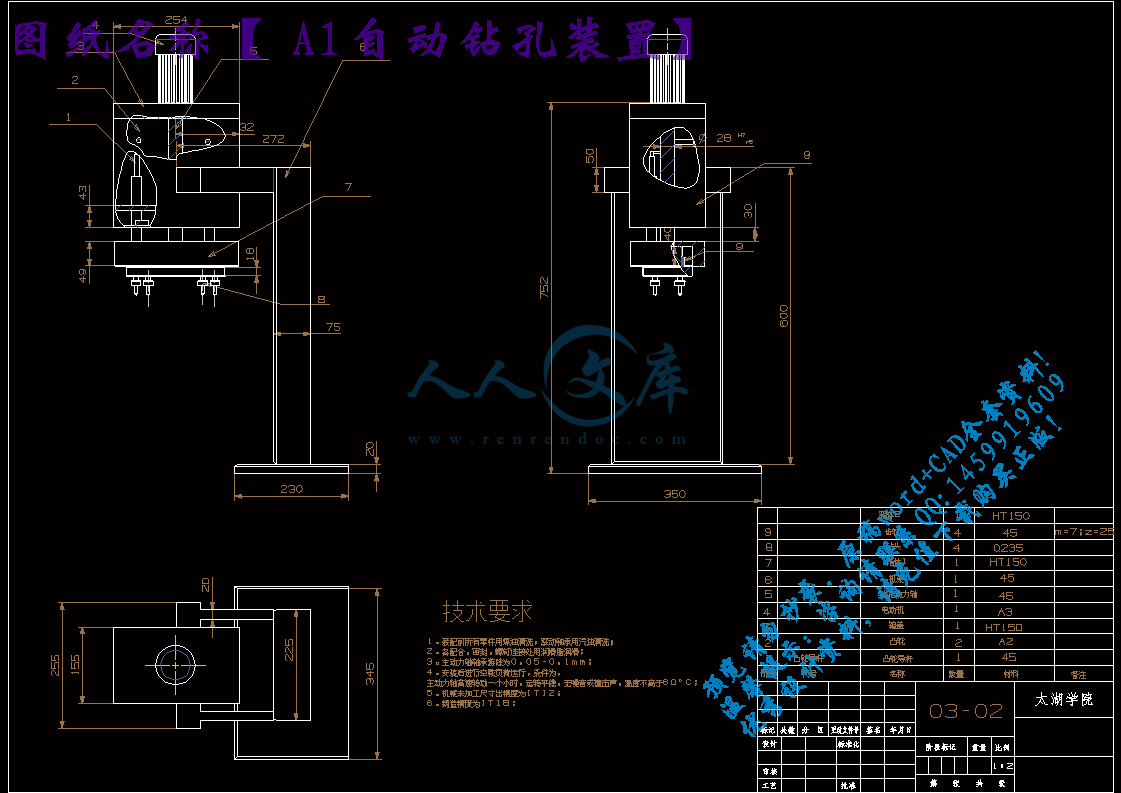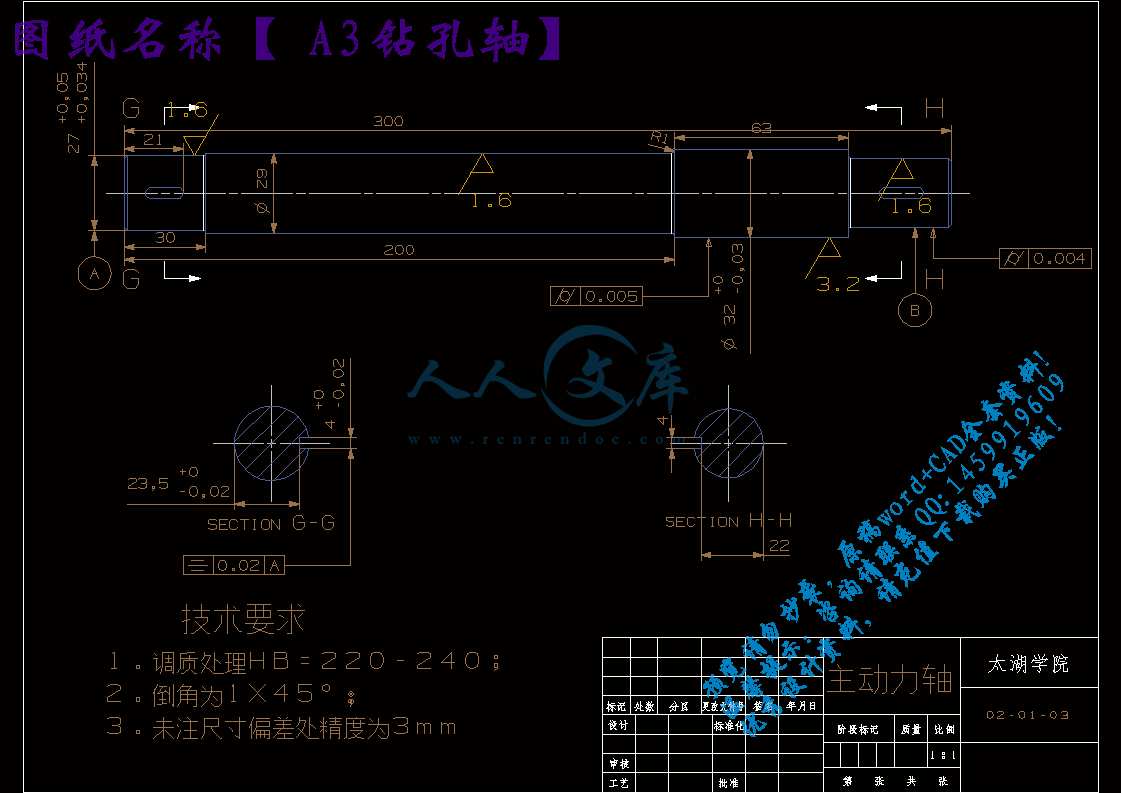围板包装箱自动化生产线铆接装置的设计【优秀】【word+8张CAD图纸】【毕业设计】
【带任务书+开题报告+外文翻译】【45页@正文24900字】【详情如下】【需要咨询购买全套设计请加QQ1459919609】.bat
围板包装箱自动化铆接装置的设计正文.doc
A1自动钻孔装置.dxf
A1自动铆接装置.dxf
A3大齿轮.dxf
A3送钉装置.dxf
A3钻孔轴.dxf
A3铆接轴.dxf
A4小齿轮.dxf
PDF打印图
UGsanweimoxing
任务书.doc
开题报告.doc
整体设计A0.dxf
文献翻译.doc
计划周记进度检查表--仅供参考.xls
任 务 书
一、题目及专题:
题目 围板包装箱自动化生产线铆接装置的设计
二、课题来源及选题依据
课题来源:工厂
选题依据:围板箱是由托盘、箱体和箱盖三部分组成,组成每层围板的四片木板用铰链连接。由于装箱的灵活性、对装载物的适应性和重复使用性,围板箱被广泛应用与机械、化工、电子、五金一集其他领域的物流配送,具有能回收、降低成本、环保等优点。
作为产品外包的物流设施,围板箱越来越受客户的欢迎,使用量巨大。然而, 现有的围板箱生产方式落后, 在生产中人为因素较大,这使得围板箱的生产上存在着生产效率低,质量不稳定等缺陷。 这严重影响着围板箱的应用。为了提高劳动生产率, 降低工人劳动强度, 节约生产成本, 我们对围板箱的现有生产工艺进行了研究,设计出了适应与围板箱生产的围板自动化生产线铆接装置。
三、本设计(论文或其他)应达到的要求:
① 熟悉围板包装箱加工的发展历程,以及近几年对围板包装箱生产工艺的改进方法
② 熟练掌握用UG 绘制三维模型的方法
③了解近几年对围板箱生产工艺的改进
④设计出合理的围板包装箱自动化生产线铆接装置
摘 要
围板箱作为产品外包的物流设施,具有可重复使用,能回收、降低成本、环保等优点。且越来越受客户的欢迎,使用量巨大。然而,现有的围板箱生产方式落后,并且在生产中人工所占工作量较大,这使得围板箱的生产上存在着生产效率低,劳动强度高以及质量不稳定等隐患,严重影响着围板箱推广和应用。为了提高劳动生产率,降低工人劳动强度,节约生产成本,我们对围板箱的现有生产工艺进行了分析研究,对现有工艺进行综合、设计,设计出了适应与围板箱生产的自动化生产线铆接装置。本文就自动铆接装置的设计做以下说明。
1) 通过对现有围板箱生产工艺的分析研究,并结合实际生产过程中对围板箱生产上的要求,提出了对围板包装箱生产工艺的改进方案,通过比较,分析其合理性和可行性。
2) 将所设计的围板包装箱自动化生产机构分成七大部分,并以凸轮技术为基础,分别进行设计,通过试验分析最终完成了自动钻铆机的设计。
3) 设计完成以后,利用三维建模软件UG建立了自动钻铆机中的钻孔、钻铆系统的三维实体模型,包括弧面凸轮转位机构,铆接机构等。
4) 利用动力学分析软件ADAMS对弧面凸轮转位机构的虚拟样机进行了运动学分析,得出了工作时的铆接筒的转位角速度、角加速度。这为弧面凸轮分度机构的优化提供了参照。
利用建立的铆接系统中的转位机构、钻孔机构的虚拟样机,进行了仿真
分析,得到了机构中从动件的运动规律及受力情况,这对我们在进行围板包装箱 自动化生产线铆接装置的设计及机构的修改有一定的指导意义,也为我们的设计节省了时间,减少了经济损失。
关键词:围板箱,自动钻孔、铆接装置,凸轮机构
Abstract
Coaming box as product outsourcing logistics facilities, is a reusable, can recycling, reduce cost, environmental protection, etc. And more and more popular with customers, huge usage.however, the existing coaming box backward production mode, and in the production of artificial workload is bigger, which makes the coaming box production there is a low production efficiency, high labor intensity and the quality is not stable etc, seriously affecting the coaming box promotion and application. In order to improve the labor productivity, reduce the workers labor intensity, saving the production cost, our existing to coaming box, this paper analyzes the production technology, comprehensive, design of the existing technology, designed the coaming box production to adapt to a riveting device of the automatic production line. In this paper, the design of automatic riveting device to do the following instructions.
1) through the analysis of the existing coaming box production technology research, and combining the actual production process to coaming box production request, proposed to the coaming packing production process improvements, through the comparison, analysis of its rationality and feasibility.
2) to the design of the automatic drilling and riveting machine is divided into seven parts, and on the basis of CAM technology, design, respectively, through the test analysis finally completed the design of the automatic drilling and riveting machine.
3) after the completion of the design, the use of three-dimensional modeling software UG to establish the automatic drilling and riveting machine in the virtual prototype model of drilling and riveting system, including the curved CAM indexing mechanism, riveting, etc.
4) using dynamic analysis software ADAMS to curve of CAM indexing mechanism, the authors carried out a kinematical analysis on the virtual prototype, the work is obtained when the riveting tube inversion angular velocity and angular acceleration. For the curve of CAM indexing mechanism that provides reference to optimization.
Of riveting system with built in indexing mechanism, the drilling mechanism of virtual prototype and simulatedAnalysis, obtained the institutions of follower motion law and force, it in the coaming for our packing automatic production line riveting device design and mechanism of modification has certain guiding significance, as well as our design saves time, reduces the economic loss.
Key words: coaming box, automatic drilling and riveting equipment, the CAM mechanism
目 录
摘 要III
AbstractIV
目 录V
1. 绪论1
1.1 对围板包装箱生产工艺方法的分析及意义1
1.2 国内外的发展概况1
1.3 围板箱的组成及优点2
2. 围板箱生产线的工艺分析3
2.1 围板箱生产现状的介绍3
2.2对围板加工工艺方法的确定4
3. 围板包装箱自动化生产工艺的设计要求及整体结构的分析6
3.1 围板包装箱自动化生产线铆接装置的设计要求6
3.2 自动化钻孔铆接技术的概述6
3.3 围板包装箱自动化铆接装置设计的整体结构分析6
3.3.1 整体机构的分析6
3.3.2 总体结构的设计7
3.4 围板包装箱自动化铆接装置的工作循环分析8
3.4.1 钻孔机构的工作循环8
3.4.2 弧面凸轮分度机构的工作循环8
3.4.3 铆接机构的工作循环8
3.4.4 压紧机构的工作工作循环8
3.4.5 送钉机构的工作循环8
4.围板包装箱自动化生产线主体结构的设计9
4.1 钻孔机构的结构设计9
4.2 铆接机构的设计10
4.3主动力轴的设计和校核及齿轮传动系统的设计14
4.3.1 主动力轴的设计和校核14
4.3.2 齿轮传动系统的设计16
4.3.3 钻孔机构齿轮系统的设计与计算17
4.3.4 铆接机构齿轮系统的设计与计算20
5. 弧面分度凸轮机构的设计21
5.1 弧面分度凸轮机构的结构分析21
5.2 弧面凸轮具体参数的确定22
5.2.1 分度数及分度角的计算22
5.2.2 动静比K和凸轮动程角22
5.2.3 计算中心距22
5.2.4 计算凸轮的滚子尺寸23
5.2.5 从动盘的尺寸23
5.2.6 凸轮尺寸的确定23
6. 凸轮机构的设计24
6.1 凸轮机构的设计要求及结构方案的确定24
6.2钻孔、铆接工艺加工过程的分析24
6.3钻孔凸轮及铆接凸轮结构的设计和分析24
6.3.1凸轮机构分析24
6.3.2 凸轮机构中个参数的确定25
6.5 沟槽凸轮理论轮廓的设计26
7.送钉机构压紧机构的设计及工作原理28
7.1压紧机构的设计及工作原理28
7.2 送钉系统的结构设计和工作原理28
7.2.1 送钉装置结构组成28
7.2.2 铆钉的种类和规格29
7.2.3 自动供钉装置的功能需求30
7.2.4 自动供钉装置的结构组成30
7.2.5 铆钉整理定向模块31
7.3 送钉原理介绍32
7.3.1 大压块的设计32
7.3.2 搓板的设计33
8. 动力系统的分析34
8.1 钻孔铆接机构动力系统分析34
8.2 电动机转速的确定35
8.3 V带传动的设计及相关的参数计算36
8.3.1带传动受力分析36
8.3.2 带传动的最小初拉力和临界摩擦力36
8.3.3 带的应力分析37
8.3.4带传送设计计算38
9. 总结与展望39
9.1 总结39
9.2 展望39
致 谢40
参 考 文 献41
1. 绪论
1.1 对围板包装箱生产工艺方法的分析及意义
在循环包装系统里,方便灵活的围板箱有着无可比拟的优势。这是一种标准的物流器具,损坏的顶盖与侧板很容易进行替换,整体循环包装系统的投资比较低廉,而使用寿命则可达十年之久,这也是一种可靠的坚固的可以折叠的包装系统。由于装箱的灵活性、对装载物的适应性和重复使用性,围板箱被广泛运用于机械、化工、电子、五金以及其他领域,围板包装箱作为产品外包的物流设施,越来越受客户的欢迎,使用量巨大。然而,现有的围板箱生产方式落后, 在生产中人为因素较大,这使得围板箱的生产上存在着生产效率低, 质量不稳定等缺陷,这严重影响着围板箱的应用。针对现有围板工艺生产方法进行改进,设计出适用于围板生产的围板自动化生产线铆接装置,提高劳动生产率,降低工人劳动强度,节约生产成本。
1.2 国内外的发展概况
围板包装箱作为产品的外包物流设备具能够重复使用,可回收、降低运输成本、环保等优点。在运输产品方面受到广泛的运用,需求日益增加。现有的围板箱生产方式落后,并且在生产中人为因素较大,这使得围板箱的生产上存在着生产效率低,质量不稳定等缺陷,严重影响着围板箱的应用。
在国内,围板箱是一款可反复循环使用的新型包装,适用于紧固件、金属球、冲压件等不规则产品的包装,是出口到欧洲的产品包装的不二选择。围板箱基本以木板为主要材料,而侧板大多数都是采用模板或者大板制作,使得材料的选取过于苛刻,而且成本比较高。目前围板箱的生产也主要以人工为主,木板加工以半自动化为主,因此在生产中人为因素较大,这就导致围板箱的生产上存在着生产效率不高, 质量不稳定等缺陷,影响了围板的推广和运用。而在国外,德国KTP公司可以说是制造围板箱的代表,经过其几代人的努力,现今已经研制出了可折叠式塑料围板箱如图1.1所示。其生产方式也采用了全自动化的生产线模式,箱子规格也都已经基本标准化,方便统一规格生产。
参 考 文 献
刘朝儒,彭福荫,高政一.机械制图[M],北京:高等教育出版社.2001.
王文斌.机械设计手册[M],北京:机械工业出版社,2004.
铁位麟.机床备件手册[M],北京:机械工业出版社.1992.
曹惟庆,徐曾荫.机构设计[M],北京:机械工业出版社.1994.
刘加利.弧面凸轮设计与精密加工的研究[D],山东淄博:山东理工大学,2006.
张建民.机电一体化系统[M],北京:北京理工大学出版社.2000.
张力勋,孟庆鑫.机电一体化系统设计[M],哈尔滨:哈尔滨工程大学出版社.1990.[8]
严道发.电主轴技术综述[J].机械研究与应用,2006(12),V01.19 No.6:1~3.
吴武辉.球齿轮数控磨齿机结构设计与分析[D].湖南:国防科学技术大学机械工程,2007.
周延,李中行.电主轴的电动机及其驱动模块[J].制造技术与机床,2003(9):86~87.
曹巨江,陈雪峰.弧面凸轮诱导主曲率与接触应力[J].机械设计,2001,(11):10~11.
白银科,曹西京.磁性研磨在弧面凸轮加工中的应用[J].组合机床与自动化加工技术2009,(9):82~85.
徐芝纶.弹性力学(第三版)上册.北京:高等教育出版,1999.
张海波.基于虚拟样机技术的自卸汽车作业稳定性研究[D],青岛:青岛大学,2008.
刘加利.弧面凸轮设计与精密加工的研究[D].山东淄博:山东理工大学,2006.
刘言松,贺伟.弧面凸轮三维实体模型的建立[J].组合机床与自动化加工技术,2004,36~37.










 川公网安备: 51019002004831号
川公网安备: 51019002004831号